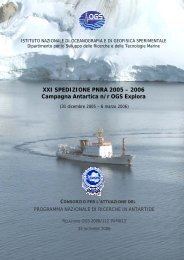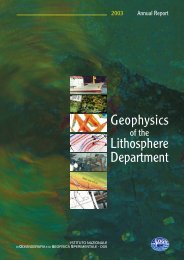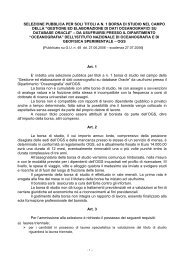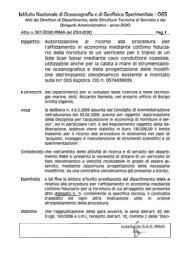Geophysical data acquisition - OGS
Geophysical data acquisition - OGS
Geophysical data acquisition - OGS
Create successful ePaper yourself
Turn your PDF publications into a flip-book with our unique Google optimized e-Paper software.
Structure and Cenozoic evolution of the South America –<br />
Scotia plate boundary in the Tierra del Fuego region<br />
E. LODOLO<br />
R. GELETTI<br />
Onshore field geological and geophysical studies, and a multichannel seismic<br />
survey have been conducted in the last two years in the Tierra del Fuego region, in<br />
the frame of an Argentinean-Italian scientific research. The main aim of this<br />
project was to analyse the regional geological setting of the Island and reconstruct<br />
the Cenozoic geodynamic evolution of an important segment of the South<br />
America-Scotia plate boundary, called Magallanes-Fagnano fault system. This is a<br />
mainly wrench lineament which cuts across the Island and runs from the Pacific<br />
entrance of the Magallanes Strait to the Atlantic coast of the Island. The Lago<br />
Fagnano, located in the central part of the Tierra del Fuego, is an E-W-trending<br />
major depression which hides part of the fault, as revealed by the bathymetric map,<br />
which shows the presence of significant and steep scarps in correspondence of the<br />
onshore prosecution of the lineament. In cross-section, this tectonic lineament is<br />
represented by sub-vertical faults and associated asymmetric basins, generated by<br />
simultaneous strike-slip motion and transform-normal extension, as imaged by<br />
the seismic profiles acquired off the Atlantic coast of the Island and in the central<br />
and western Magallanes Strait.<br />
Data analyses support the interpretation that the Magallanes-Fagnano fault system<br />
is remarkably transtensive in nature, and is structurally and temporally<br />
superposed on the older tectonic framework of the Tierra del Fuego (i.e., the<br />
contractional system of the Magallanes fold and thrust belt), even if the<br />
displacement history of this fault system is unclear. The near parallelism among<br />
the younger and older lineaments suggests that the development of the<br />
transtensional structures may have reactivated pre-existing weakened zones<br />
formed by the Cretaceous-Tertiary shortening.<br />
Mapping the BSR on the South Shetland Margin<br />
(Antarctica) and assessing gas hydrate and free gas<br />
quantities<br />
E. LODOLO<br />
A. CAMERLENGHI<br />
G. MADRUSSANI<br />
G. ROSSI<br />
U. TINIVELLA<br />
Bottom Simulating Reflectors (BSRs) along the South Shetland continental<br />
margin have been first identified by <strong>OGS</strong> researchers on two multichannel seismic<br />
profiles acquired by the R/V <strong>OGS</strong>-Explora (1990 Antarctic Campaign). A dedicated<br />
survey was conducted on 1997 to purposely map the extent of the BSR on this<br />
margin, and study the relationships between geological structure and gas hydrate<br />
and free gas distribution. Processing and interpretation of the collected grid of<br />
high-resolution multichannel seismic reflection profiles have been completed<br />
(about 700 km of <strong>data</strong>), and have allowed us to map the lateral extent of the BSRs.<br />
The South Shetland continental margin, an accretionary wedge located off the<br />
northern tip of the Antarctic Peninsula, consists of two distinct and superimposed<br />
tectonic regimes: an older regime is related to Mesozoic - Middle Cenozoic<br />
subduction-related tectonism; a younger one is associated with a mainly<br />
46






